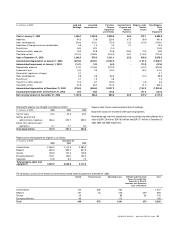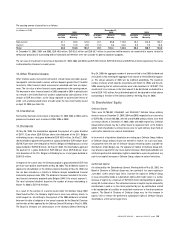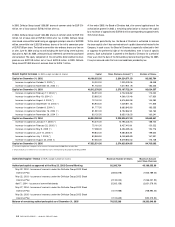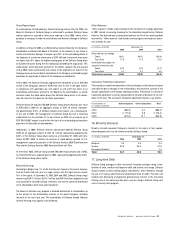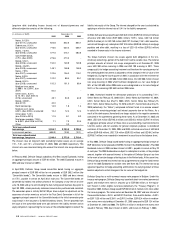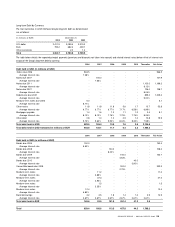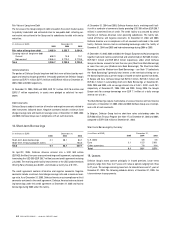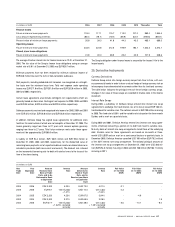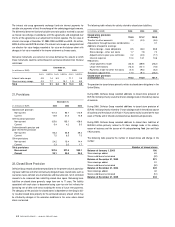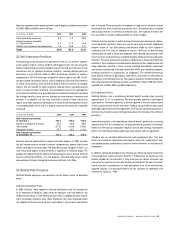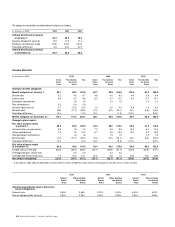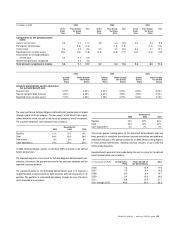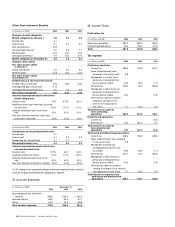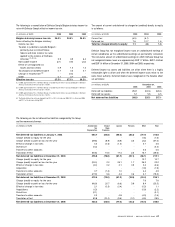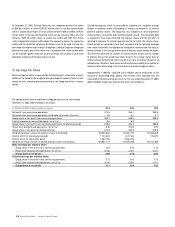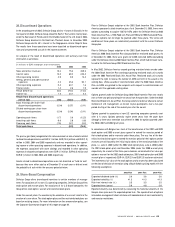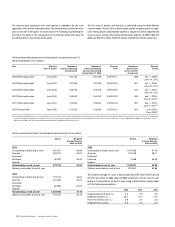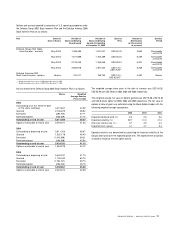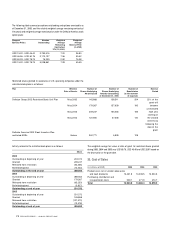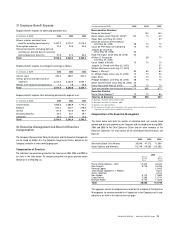Food Lion 2005 Annual Report Download - page 65
Download and view the complete annual report
Please find page 65 of the 2005 Food Lion annual report below. You can navigate through the pages in the report by either clicking on the pages listed below, or by using the keyword search tool below to find specific information within the annual report.
Expenses recorded in the income statement and charged to closed store provision
for 2005, 2004 and 2003 were as follows:
(in m illions of EUR) 2005 2004 2003
Other operating expenses 9.5 1.2 38.3
Interest expense included
in “ finance costs” 9.4 11.2 13.6
Results from discontinued operations 1.9 43.9 (0.1)
Total 20.8 56.3 51.8
23. Self-Insurance Provision
Delhaize Group is self-insured for its operations in the U.S. for workers’ compen-
sation, general liability, vehicle accident and druggist claims. The self-insurance
liability is determined actuarially, based on claims filed and an estimate of claims
incurred but not yet reported. Maximum retention, including defense costs per
occurrence, is from USD 0.5 million to USD 1.0 million per accident for workers’
compensation, USD 5.0 million per accident for vehicle liability and USD 3.0 mil-
lion per accident for general liability, with an additional USD 2.0 million retention
in excess of the primary USD 3.0 million general liability retention for druggist
liability. We are insured for costs related to covered claims, including defense
costs, in excess of these retentions. The assumptions used in the development
of the actuarial estimates are grounded upon our historical claims data, including
the average monthly claims and the average lag time between incurrence and
payment. It is possible that the final resolution of some of these claims may
require us to make significant expenditures in excess of the existing reserves over
an extended period of time and in a range of amounts that cannot be reasonably
estimated.
(in m illions of EUR) 2005 2004 2003
Self insurance provision
at January 1, 109.3 113.6 119.6
Expense charged to earnings 42.0 44.8 58.5
Claims paid (37.0) (40.8) (43.5)
Translation effect 16.7 (8.3) (21.0)
Self insurance provision
at December 31, 131.0 109.3 113.6
Delhaize America implemented a captive insurance program in 2001 whereby
the self-insured reserves related to workers’ compensation, general liability and
vehicle coverage were reinsured by The Pride Reinsurance Company (“Pride” ), an
Irish reinsurance captive wholly-owned by a subsidiary of Delhaize Group. The
purpose for implementing the captive insurance program was to provide Delhaize
America continuing flexibility in its risk program, while providing certain excess
loss protection through anticipated reinsurance contracts with Pride.
24. Benefit Plan Provision
Delhaize Group’s employees are covered by certain benefit plans, as described
below.
Defined Contribution Plans
In 2004, Delhaize Group adopted a defined contribution plan for substantially
all its employees in Belgium, under which the employer, and, from 2005 on, the
employees contribute a fixed monthly amount which is adapted annually accord-
ing to the Belgian consumer price index. Employees that were employed before
the adoption of the plan could opt not to participate in the personal contribution
part of the plan. The plan assures the employee a lump-sum at retirement, based
on contributions, with a minimum guaranteed return. The pension plan is insured
and is accounted for as a defined contribution plan. The expense related to the
plan was EUR 2.7 million in 2005 and EUR 2.7 million in 2004.
Delhaize America sponsors a profit-sharing retirement plan covering all employ-
ees at Food Lion and Kash n’ Karry with one or more years of service. Employees
become vested in any profit-sharing contributions made by their respective
employers after five years of consecutive service. Forfeitures of profit-sharing
contributions are used to offset plan expenses. Profit-sharing contributions to the
retirement plan are discretionary and determined by Delhaize America’s Board of
Directors. The profit-sharing plan includes a 401(k) feature that permits Food Lion
and Kash n’ Karry employees to make elective deferrals of their compensation and
allows Food Lion and Kash n’ Karry to make matching contributions. Hannaford
and Harveys also provide a defined contribution 401(k) plan including employer-
matching provisions to substantially all employees. The defined contribution
plans provide benefits to participants upon death, retirement or termination of
employment with Delhaize America. The expense related to the defined contribu-
tion retirement plans of Delhaize America was EUR 36.1 million, EUR 32.8 million
and EUR 42.2 in 2005, 2004 and 2003 respectively.
Defined Benefit Plans
Delhaize Belgium has a contributory defined benefit pension plan covering
approximately 5% of its employees. The plan provides benefits to participants
upon death or retirement based on a formula applied to the last annual salary
of the associate before his/her retirement. Delhaize Group funds the plan based
upon legal requirements and tax regulations. An insurance company guarantees a
minimum return on plan assets. Delhaize Group bears the risk above this minimum
guarantee.
Hannaford maintains a non-contributory defined benefit pension plan covering
approximately 50% of its employees. The plan provides for payment of retirement
benefits on the basis of employees’ length of service and earnings. Hannaford’s
policy is to fund the plan based upon legal requirements and tax regulations.
Alfa-Beta has an unfunded defined benefit post-employment plan. This plan
relates to termination indemnities prescribed by Greek law, consisting of lump-
sum compensations granted only in cases of normal retirement or termination of
employment.
In addition, Hannaford provides certain health care and life insurance benefits for
retired employees (“post-retirement benefits”). Substantially all employees may
become eligible for these benefits if they reach early or normal retirement age
and accrue ten years of service while working for Hannaford. The post-retirement
health care plan is contributory for most participants with retiree contributions
adjusted annually. Life insurance benefits are not available for employees who
retired after January 1, 1996.
DELHAIZE GROUP / ANNUAL REPORT 200 5 63


